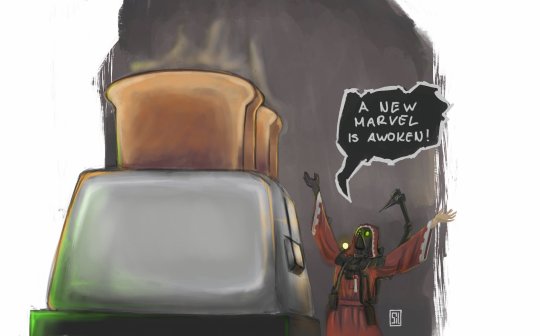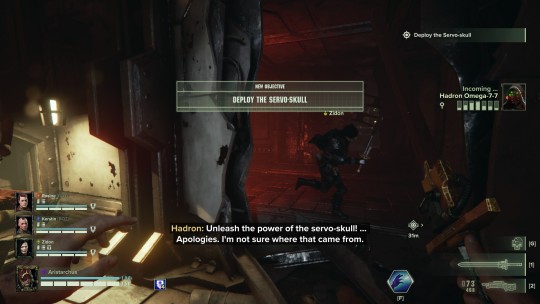#hadron omega -7-7
Explore tagged Tumblr posts
Text
Hadron 7-7 11/01/24

Digital drawing of everyone's favorite grumpy robot grandma, Hadron Omega-7-7! I drew this Digitally with Krita, Omnissiah be praised.
#warhammer 40000#warhammer 40k#warhammer#imperium#40k#techpriest#tech priest#darktide#hadron omega -7-7#Omnissiah#digital#digital art#digital drawing#adeptus mechanicus#art#artwork#fanart#krita#artists on tumblr#video games#games#gaming#mars#cult of mars#machine spirit
65 notes
·
View notes
Text

i love my misanthropic robot wife
#hadron#Hadron Omega 7-7#darktide#warhammer 40000#warhammer 40k#adeptus mechanicus#admech#techpriest#40k
194 notes
·
View notes
Text

389 notes
·
View notes
Text


if i had a nickel for every time i encountered a character partially named after the Large Hadron Collider who showed considerable aptitude for engineering machinery and large-scale robotics i would have two nickels, which isn't a lot, but it's weird that it happened twice, right?
10 notes
·
View notes
Text

#warhammer 40000 darktide#warhammer 40000#darktide#hadron omega-7-7#hadron#darktide hadron#adeptus mechanicus#techpriest
132 notes
·
View notes
Text

I made an entry for Darktide's Hadron art contest!
37 notes
·
View notes
Photo


...anyone else wondering if this is meant as a reference to He-Man...? Would be a nice pun done with a tech-priest... xD
youtube
#wh40k#warhammer 40k#darktide#hadron#hadron omega-7-7#he-man#grey-skull#servo-skull#techpriest#tough women#adeptus mechanicus#game#played
15 notes
·
View notes
Text
Summoned, I submit to your request and your authority, technoarchaeologist

Hadron Omega 7-7 and Kayex-8 with no shading :)
#not bugs#admech#techpriest#darktide#warhammer 40k#adeptus mechanicus#ok but why is Kayex-8 so dreamy tho#he just sounds so romantic >///<#Hadron needs no explanation#and they look so good together#my bi ass is struggling#also i wanted to go with a trad doodle for them#but then after i inked it i noticed that i gave Kayex two left hands#freaking HATE IT when i do that
27 notes
·
View notes
Photo

Hadron Omega-7-7
Artwork of the character Hadron Omega-7-7 from Warhammer 40k: Darktide. Acrylic paint on illustration board.
This is Ross's entry into developer Fatshark's #DarktideArtContest for this character, and an example of the traditional illustration work we do!
Posted using PostyBirb
#40k#Warhammer#Scifi#Fantasy#Admech#Mechanicus#Fatshark#Fanart#Traditional#Acrylic#Darktide#DarktideArtContest
162 notes
·
View notes
Text
hello!! i’m sav :) i’m 24, from scotland, and i follow back from @blasphemme. i used to be @pleiadesnuts!!
this blog used to be a collection of posts that i liked but didn’t want on my main blog. now, it’s steadily becoming a warhammer sideblog. how things change!
i’ve just started reading the horus heresy series, but i’m a big fan of all things orky and my main babygirl, ciaphas cain. i’ve also just started painting models!! so i may share some of those i think if they turn out well.
i suppose i should mention the things i’ve written.
WH40K: DARKTIDE anointed — you entreat hadron. read on ao3. hadron omega-7-7/fem!veteran reader.
THE HORUS HERESY garviel loken earns his wings — a WIP. read here. garviel loken/fem!oc. very very early days here.
more to come, and more to be added. the emperor protects 🦅 ❤️
1 note
·
View note
Note
The game itself is meh, but Warhammer: Darktide (basically Left 4 Dead in WH40K) has a snarky, annoyed Tech Priestess who insults your characters over comms, if you want to look up that. Her name's Hadron Omega 7-7.
omg i watched a vid of her and she rules... i like that she is always holding a skull...pondering it... putting her on my board of favorite tech priests along w tech-acquisitior scaevola and pasqal
#asks#she has a tiny bit of a glados vibe and i like her voice a lot#also she is very casual for a tech priest lol#the game kinda reminds me of vermintide but i guess its just the same just in space lol
4 notes
·
View notes
Text
When Hadron Omega 7-7 calls me a good varlet

56 notes
·
View notes
Photo

Feelin' Low (F*ckboy Blues) - Peach pit I want something always, more or less than what I have Could be nothing but I'll go and look to be had You couldn't make it up Least I don't think so As you're coming on And I'm backing up feeling low All my wretched little recipes are the same Add one cup of from you, and you'll know me by name You couldn't make it up Least I don't think so As you're coming on And I'm backing up, feeling low Just last Tuesday morning I recalled you at once Your eyes shifting right on past my dumb fucking mug You couldn't make it up Least I don't think so As you're coming on And I'm backing up, feeling low 크사이입자 입자물리학에서 바리온로 분류되는 중성자의 일종이다. 크사이 중입자 또는 캐스케이드 중입자라고도 부른다.그리스 문자 Ξ로 표시되는 갖는 아원자 강입자(hadron) 군이며 @@NAMATH_INLINE@@+2e@@NAMATH_INLINE@@, @@NAMATH_INLINE@@+1e@@NAMATH_INLINE@@, @@NAMATH_INLINE@@0@@NAMATH_INLINE@@ 또는 @@NAMATH_INLINE@@-e@@NAMATH_INLINE@@의 전하 (@@NAMATH_INLINE@@Q@@NAMATH_INLINE@@)를 가질 수 있으며, 여기서 @@NAMATH_INLINE@@e@@NAMATH_INLINE@@는 단위 전하이다. 다른 중입자등처럼, 크사이 입자는 3 개의 쿼크로 구성된다. 특히 상하(up, down) 쿼크 1 개와 더 큰 쿼크 2 개 (기묘, 매력, 바닥: strange, charm, bottom)를 포함한다. 역사적으로 이들 중입자는 매우 불안정한 상태로 발견되며 이로 인해 캐스케이드 입자라고 불리기도 하며, 일련의 붕괴과정을 통해 더 가벼운 입자로 빠르게 붕괴된다. 그림 1. 크사이입자 (출처:한국물리학회) 전하를 가진 크사이 입자는 1952년 맨체스터(Manchester ) 그룹의 우주선 실험에서 발견되었다. 전하가 없는 중성 크사이 입자는 1959 년 로렌스-버클리 실험실(Lawrence Berkeley Laboratory)에서 최초로 발견되었고, 오메가 중입자(@@NAMATH_INLINE@@\Omega@@NAMATH_INLINE@@)의 붕괴로 생긴 입자로부터도 중성 크사이 입자가 관찰되었다. 이론적으로도 크사이 입자의 스펙트럼은 격자 QCD(lattice QCD)와 같은 비섭동론적 양자색역학(QCD)에서 맛깔 대칭성(flavor symmetry)의 파괴의 관점에서 매우 중요하다. 크사이 중입자는 불안정한 상태에서 캐스케이드 입자라고도 부르고, 붕괴 사슬을 통해 더 가벼운 입자로 붕괴한다. 1964년 브룩 헤이븐 국립 연구소에서 처음 발견 된 것으로 되어 있지만, 그 이전인 1954년 클라이드 변함에 의해 발견되었다고하는 설명도있다. 그림 2. 크사이 중입자 (출처:한국물리학회) @@NAMATH_INLINE@@\Xi_b@@NAMATH_INLINE@@는 3세대의 쿼크를 모두 포함한다. Fermi 국립 가속기 연구소의 D0과 CDF 실험에 의해 발견되어 2007 년 6 월 12 일에 공표되었다. 3세대 모든 쿼크로 이루어진 입자가 발견 된 것은 처음으로, 아래 쿼크, 기묘 쿼크, 바닥 쿼크로 구성되어 있었다. D0 그룹은 @@NAMATH_INLINE@@5.774\pm0.019@@NAMATH_INLINE@@ GeV/c@@NAMATH_INLINE@@^2@@NAMATH_INLINE@@는 질량을 측정했지만, CDF 그룹은 @@NAMATH_INLINE@@5.7929\pm0.0030 @@NAMATH_INLINE@@ GeV/c@@NAMATH_INLINE@@^2@@NAMATH_INLINE@@는 질량을 측정했다. 이 두 측정 값은 서로 모순되고 있지만, 파티클 데이터 그룹 world average mass는 5.7924 ± 0.0030 GeV/c2 값을 채용하고있다. 명시되지 않은 경우에는 위 쿼크와 아래 쿼크 이외의 쿼크는 기묘 쿼크이지만, @@NAMATH_INLINE@@\Xi_b@@NAMATH_INLINE@@는 위 쿼크 1개, 기묘 쿼크 1개로 바닥 쿼크 1개에서되고 @@NAMATH_INLINE@@\Xi^0_{bb}@@NAMATH_INLINE@@는 1개의 위 쿼크와 2개의 바닥 쿼크로 구성된다.또한 2017 년 7 월 6 일에는 CERN의 LHC에서 @@NAMATH_INLINE@@3621@@NAMATH_INLINE@@GeV/c@@NAMATH_INLINE@@^2@@NAMATH_INLINE@@의 질량을 가진 @@NAMATH_INLINE@@\Xi^+_{cc}@@NAMATH_INLINE@@는 입자가 합성 된 것으로 발표되었다. 이번 실험에서는 합성 재현 실험도 진행하지만, 과거의 실험의 재현에는 이르지 못했다. 입자 기호 쿼크 구성 정지질량 [MeV/c2] 아이소스핀 스핀-패리티 전하 기묘도 매력 바닥 반감기 [초] 크사이 @@NAMATH_INLINE@@\Xi^0@@NAMATH_INLINE@@ uss 1314.86±0.20 1/2 1/2+ 0 -2 0 0 2.90 × 10-10 크사이 @@NAMATH_INLINE@@\Xi^-@@NAMATH_INLINE@@ dss 1321.31±0.13 1/2 1/2+ -1 -2 0 0 1.639 × 10-10 여기상태 크사이 @@NAMATH_INLINE@@\Xi^0@@NAMATH_INLINE@@ uss 1531.80±32 1/2 3/2+ 0 -2 0 0 여기상태 크사이 @@NAMATH_INLINE@@\Xi^-@@NAMATH_INLINE@@ dss 1535.0±6 1/2 3/2+ -1 -2 0 0 매력 크사이 @@NAMATH_INLINE@@\Xi^+_c@@NAMATH_INLINE@@ usc 2467.9±0.4 1/2 1/2+ +1 -1 +1 0 0.26 × 10-13 매력 크사이 @@NAMATH_INLINE@@\Xi^0_c@@NAMATH_INLINE@@ dsc 2471.0±0.4 1/2 1/2+ 0 -1 +1 0 1.12 × 10-13 여기상태 매력 크사이 @@NAMATH_INLINE@@\Xi^{'+}_c@@NAMATH_INLINE@@ usc 2572.7±3.1 1/2 1/2+ +1 -1 +1 0 여기상태 매력 크사이 @@NAMATH_INLINE@@\Xi_{c}^{'0}@@NAMATH_INLINE@@ dsc 2578.0±2.9 1/2 1/2+ 0 -1 +1 0 1.1 × 10-13 이중 매력 크사이 @@NAMATH_INLINE@@\Xi^{++}_{cc}@@NAMATH_INLINE@@ ucc 3621.40 1/2 1/2+ +2 0 +2 0 이중 매력 크사이 @@NAMATH_INLINE@@\Xi^+_{cc}@@NAMATH_INLINE@@ dcc 3518.9±0.9 1/2 1/2+ +1 0 +2 0 3.3 × 10-14 바닥 크사이 @@NAMATH_INLINE@@\Xi^0_b@@NAMATH_INLINE@@ usb 5792±3 1/2 1/2+ 0 -1 0 -1 1.42 × 10-12 바닥 크사이 @@NAMATH_INLINE@@\Xi^-_b@@NAMATH_INLINE@@ dsb 5792.9±3.0 1/2 1/2+ -1 -1 0 -1 1.42 × 10-12 이중 바닥 크사이 @@NAMATH_INLINE@@\Xi^0_{bb}@@NAMATH_INLINE@@ ubb 1/2 1/2+ 0 0 0 -2 이중 바닥 크사이 @@NAMATH_INLINE@@\Xi^-_{bb}@@NAMATH_INLINE@@ dbb 1/2 1/2+ -1 0 0 -2 매력 바닥 크사이 @@NAMATH_INLINE@@\Xi^+_{cb}@@NAMATH_INLINE@@ ucb 1/2 1/2+ +1 0 +1 -1 매력 바닥 크사이 @@NAMATH_INLINE@@\Xi^0_{cb}@@NAMATH_INLINE@@ dcb 1/2 1/2+ 0 0 +1 -1
0 notes
Text
New ALICE results show novel phenomena in proton collisions
As the number of particles produced in proton collisions (the blue lines) increase, the more of these so-called strange hadrons are measured (as shown by the orange to red squares in the graph) (Image: ALICE/CERN) In a paper published today in Nature Physics, the ALICE collaboration reports that proton collisions sometimes present similar patterns to those observed in the collisions of heavy nuclei. This behaviour was spotted through observation of so-called strange hadrons in certain proton collisions in which a large number of particles are created. Strange hadrons are well-known particles with names such as Kaon, Lambda, Xi and Omega, all containing at least one so-called strange quark. The observed ‘enhanced production of strange particles’ is a familiar feature of quark-gluon plasma, a very hot and dense state of matter that existed just a few millionths of a second after the Big Bang, and is commonly created in collisions of heavy nuclei. But it is the first time ever that such a phenomenon is unambiguously observed in the rare proton collisions in which many particles are created. This result is likely to challenge existing theoretical models that do not predict an increase of strange particles in these events. “We are very excited about this discovery,” said Federico Antinori, Spokesperson of the ALICE collaboration. “We are again learning a lot about this primordial state of matter. Being able to isolate the quark-gluon-plasma-like phenomena in a smaller and simpler system, such as the collision between two protons, opens up an entirely new dimension for the study of the properties of the fundamental state that our universe emerged from.” The study of the quark-gluon plasma provides a way to investigate the properties of strong interaction, one of the four known fundamental forces, while enhanced strangeness production is a manifestation of this state of matter. The quark-gluon plasma is produced at sufficiently high temperature and energy density, when ordinary matter undergoes a transition to a phase in which quarks and gluons become ‘free’ and are thus no longer confined within hadrons. These conditions can be obtained at the Large Hadron Collider by colliding heavy nuclei at high energy. Strange quarks are heavier than the quarks composing normal matter, and typically harder to produce. But this changes in presence of the high energy density of the quark-gluon plasma, which rebalances the creation of strange quarks relative to non-strange ones. This phenomenon may now have been observed within proton collisions as well. In particular, the new results show that the production rate of these strange hadrons increases with the ‘multiplicity’ – the number of particles produced in a given collision – faster than that of other particles generated in the same collision. While the structure of the proton does not include strange quarks, data also show that the higher the number of strange quarks contained in the induced hadron, the stronger is the increase of its production rate. No dependence on the collision energy or the mass of the generated particles is observed, demonstrating that the observed phenomenon is related to the strange quark content of the particles produced. Strangeness production is in practice determined by counting the number of strange particles produced in a given collision, and calculating the ratio of strange to non-strange particles. Enhanced strangeness production had been suggested as a possible consequence of quark-gluon plasma formation since the early eighties, and discovered in collisions of nuclei in the nineties by experiments at CERN[1]’s Super Proton Synchrotron. Another possible consequence of the quark gluon plasma formation is a spatial correlation of the final state particles, causing a distinct preferential alignment with the shape of a ridge. Following its detection in heavy-nuclei collisions, the ridge has also been seen in high-multiplicity proton collisions at the Large Hadron Collider, giving the first indication that proton collisions could present heavy-nuclei-like properties. Studying these processes more precisely will be key to better understand the microscopic mechanisms of the quark-gluon plasma and the collective behaviour of particles in small systems. The ALICE experiment has been designed to study collisions of heavy nuclei. It also studies proton-proton collisions, which primarily provide reference data for the heavy-nuclei collisions. The reported measurements have been performed with 7 TeV proton collision data from LHC run 1. http://home.cern/about/updates/2017/04/new-alice-results-show-novel-phenomena-proton-collisions (Source of the original content)
0 notes